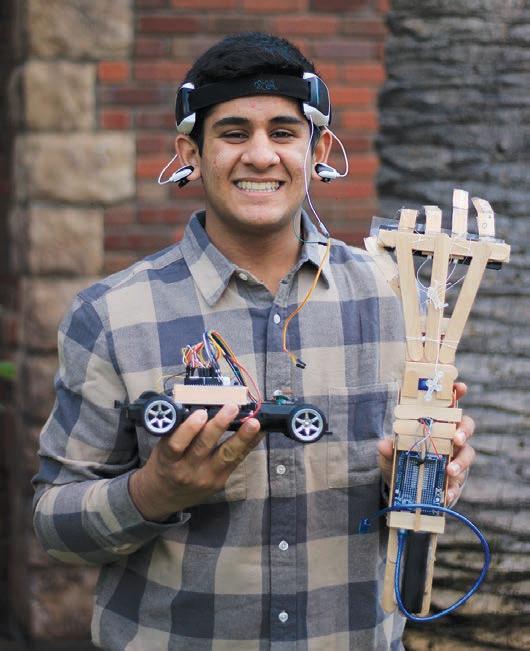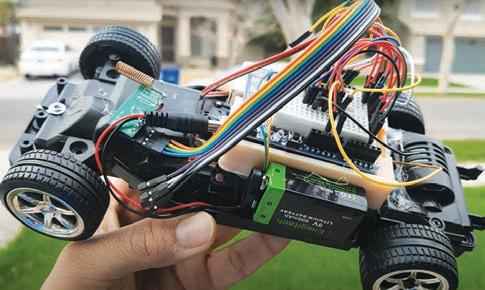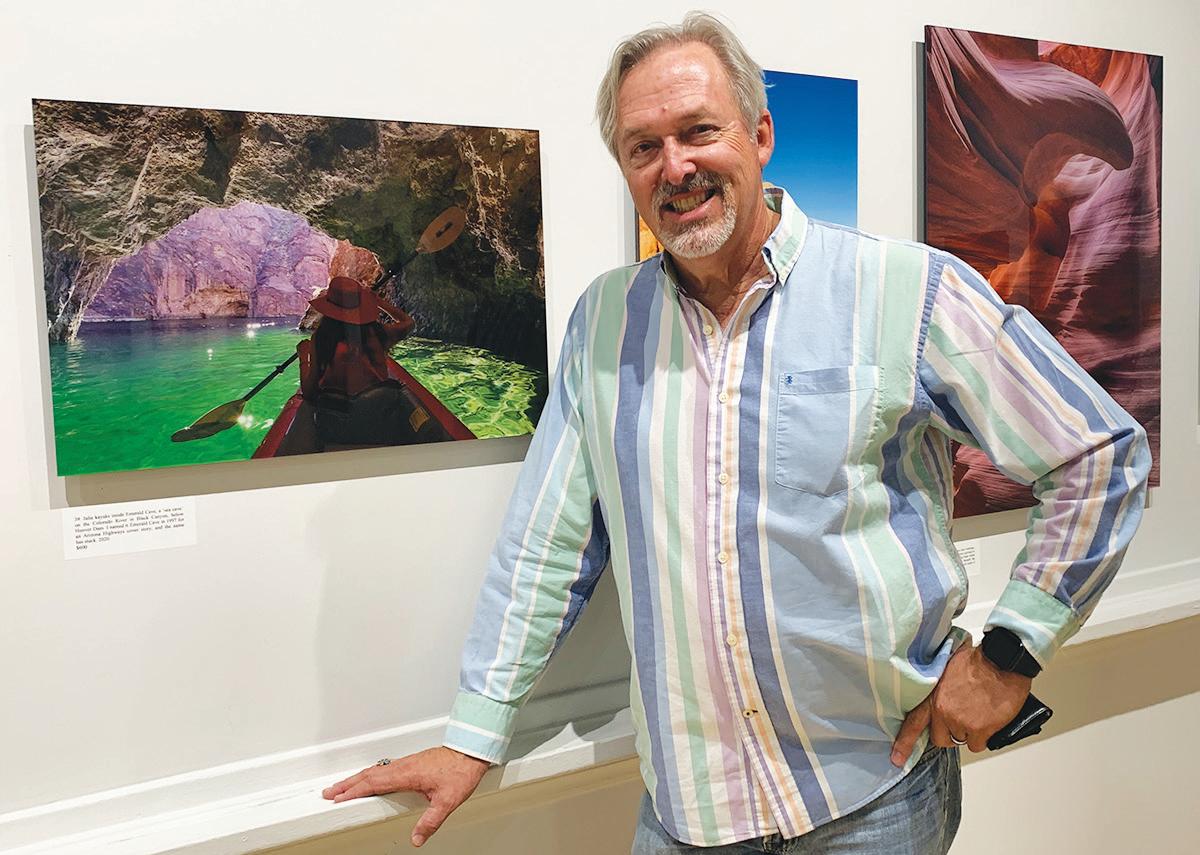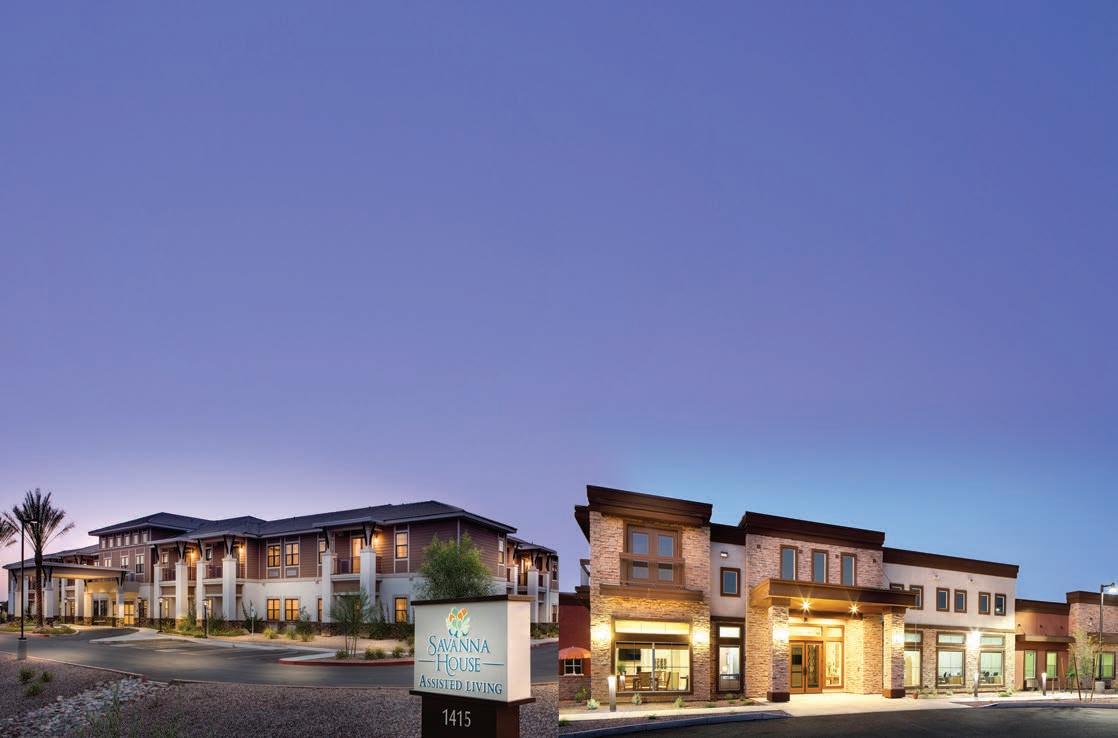
14 minute read
COMMUNITY
For more community news visit gilbertsunnews.com
GilbertSunNews.com | @GilbertSunNews /GilbertSunNews
Gilbert teen already an accomplished inventor
GSN NEWS STAFF
At 17, Mars Kapadia is already a well-seasoned inventor with innovations like a mind-control remote-control car and a pair of smart glasses that’s said to give Google a run for its money.
The Gilbert Classical Academy senior is an Arizona Science and Engineering Fair award recipient, has been featured in Popular Mechanics magazine and has his own YouTube channel where he demonstrates his technological creations. “My dad is my greatest role model,” Mars said. “My dad taught me how to go about the engineering design process and showed me real-world examples of using failure as a way to innovate products.
“He taught me my initial understanding of electronics, and although he refuses to take credit for it, almost all of my understanding of the current flow relates back to what my dad taught me about motors.”
Mars said when he was a kid, dad Perry Kapadia showed him how to make a motor operate by using just a fork and a battery. His mom is Komal Kapadia.
“’Til today I relate my knowledge of electrical engineering such as polarity, continuity, voltage and amps to that small experiment,” Mars said. “I’ve used this knowledge to build things that I deem to be initially out of my mental scope so that with each project I build, I learn one lifelong engineering skill. “When I built my hydraulic generator, I learned how to use a multimeter. In the 8th grade, I built a prosthetic hand designed for use on those with a trans-radial amputation. It taught me how to use pulse width modulation signals with a microcontroller to control the direction of a servo motor to a single degree of movement. It was also my first major experience with programming an ATmega microcontroller with C++.”
Mars said he carried his skills into building his TOLED or “transparent organic light emitting diode-based smart glasses.” The glasses reportedly use a screen, a battery, a Bluetooth module for communicating with a smartphone and an Arduino Nano, a small, complete and breadboard-friendly board.
In 2021 ELEGOO, which sponsors Mars, announced the teenager’s completion of a mind-control car, which him took six months to build.
According to the Chinese company, the project uses electroencephalogram or EEG, which maps the brain’s signals to the movement of a remote-controlled car.
In 2018, carmaker Nissan unveiled its Brain-to-Vehicle, or B2V, which uses brain-decoding technology to predict a driver’s actions and detect discomfort. By catching signs that the driver’s brain is about to initiate a movement – such as turning the steering wheel or pushing the accelerator pedal – driver-assist technologies can begin the action more quickly and improve reaction times and enhance manual driving, according to a company news release.
And, by detecting and evaluating driver discomfort, artificial intelligence
Mars Kapadia, a Gilbert Classical Academy senior, has already accumulated a
number of honors for his many inventions. (Special to GSN)

Mars Kapadia invented a car that uses brain-decoding tech-
nology to steer. (Special to GSN) see MARS page 18
HD SOUTH features photographer’s stunning work
BY SRIANTHI PERERA
GSN Contributor
Kerrick James, a Mesa photographer and travel writer known for his work locally and internationally, is featured in a show presented by Art Intersection of Gilbert.
“Arizona Odyssey: Forty Years of Roaming for Beauty,” displaying 66 images, runs through March 5 in Gallery 4 at HD SOUTH, the Home of the Gilbert Historical Museum.
James is the ultimate explorer. He has traveled the length and breadth of Arizona, looking for the rare and fleeting, the unusual and the iconic to photograph and introduce to the world.
The photographs on display were taken between 1977 and May 2021 and the presentation is as noteworthy as the content.
The photographs were printed by Artisan Colour of Scottsdale on Fuji PhotoFlex paper, then face-mounted to optically clear plexiglass acrylic and affixed to a museum mount. They seem to float off the wall.
A few of the images were printed on brushed aluminum, rendering the highlights both reflective and tactile.
James depicts iconic landscapes, ephemeral weather and celestial phenomena, billion-year-old rocks and medusa-like saguaros. There are cowboys


16 COMMUNITY GILBERT SUN NEWS | JANUARY 9, 2022 KERRICK from page 15 and horses, Hopi and Navajo dancers, adventurers and musicians. There are also images of Route 66. Some of the places are now lost to flood or time. “We have such a wide variety of landscape and culture. I could’ve done just landscapes but I wanted to have a mix of people and culture,” he said. “Photography has led me to six continents and many locales that I dreamed of as a boy growing in Kansas and California…Venice to Patagonia, Glacier Bay to China, Scotland to Costa Rica, and so many more,” he said. “But beyond the natural and cultural beauty, it is the people I’ve met because of choosing travel journalism as a career that are the heart of my trips and my memories. I always feel that there are more new and delightful images to be made, and more fascinating people to meet and learn from.” One such trip has carved an indelible mark in his memory. In 1995, the Bureau of Reclamation opened up Black Canyon, (which has Hoover Dam as its highest point) to public recreation. James was assigned by Arizona Highways magazine to create a cover feature and while exploring the 11-mile stretch of the canyon that runs north to SOUTH above Willow Beach, he discovered a “sea cave” space on the Arizona side of the Colorado River. “This was in midsummer, and I found that for a short time each afternoon, the angled rays of the lowering sun would reflect off the bottom of the cave, through the clear cold water, and create the effect of green glowing water. I felt it was like floating on an emerald so I captioned my images for their story as Emerald Cave,” he said. The name took hold and is known as such today. The story ran in September 1997 and is his favorite of 13 cover images for Arizona Highways. The Grand Canyon features in many of his images, taken during weeklong trips or just single day backpack hikes. A series of noteworthy photographs came from a 2013 trip with friends to Havasu Falls. “I carried my inflatable kayak all down there and had my friends kayak at Havasu Falls and Mooney falls and Havasu Creek,” he said. “I think it was the first time somebody had kayaked there, ever. I got some really great questions from people who were confused.” In Havasupai, he photographed a hiker from Los Angeles who happened to be there. A flash flood in 2008 changed the path of Havasu Creek and the place is no more. “It’s now as dry as a bone, but before that it was like a little piece of Hawaii,” he said. Born in Kansas and raised in Kerrick James stands near his photo of a cave in Black Canyon that he called “Emerald Cave” because California, James studied phoof the brilliant green hues. Arizona Odyssey, at HD SOUTH, celebrates the beauty of Arizona through tography and fine arts at Arizona the Mesa photographer’s lens. (Srianthi Perera/GSN Contirbutor) State University and graduated in 1982. He has lived in Arizona since 1990. Alan Fitzgerald, owner of Art Intersection, has shown James’s work in his gallery earlier, but not in a solo show. “His work, I think, brings to all of us the vision of Arizona,” Fitzgerald said. “All the four corners and some of the big monuments of Arizona and places that I don’t think many of us get to because of the distance off the roads. He captures that. I like his photography; I always have.” To those who would like to learn from a master, James teaches workshops next year across Arizona and New Two river guides admire the view downstream from the Mexico for Arizona HighNankoweap granary trail. This is one of the best Colorado ways PhotoScapes; in River views in the Grand Canyon. (Courtesy of Kerrick James) the Palouse, a picturKerrick James’s favorite season to photograph Arizona is the esque area in SOUTHeast monsoon, when massive T-storms birth rainbows that frame Washington State; and in epic landforms like the Mittens. (Courtesy of Kerrick James) see KERRICK page 17

KERRICK from page 16 the Swiss Alps. He’s also planning small group custom photo safaris to Scotland, Greece, Italy and Chile. “Photography is perfectly suited for learning on vacation, and digital has made mastering photo techniques much easier and faster as well,” he noted. “I think a show like this is about savoring the beauty of the state, but it’s also, for me, about thinking about saving it. When I first came to Arizona in the ’80s, we had about 2 million (population) in Arizona. Now we are at 7.56 or something like that. It’s putting the pressure on some of these great places.” He stressed the need for care. “It’s not that it’s a bad thing, we just have to be more careful about how we take care of what we have so we have it for our kids,” he said. “And that’s absolutely the sentiment that I want to convey.” “Arizona Odyssey: Forty Years of Roaming for Beauty,” runs through March 5 at Gallery 4, HD SOUTH, 10 S. Gilbert Road,Gilbert. Details: hdSOUTH.org and artintersection.com
1415 N. San Benito Dr., Gilbert, AZ 85234 (480) 900-2746 • SavannaHouse@mbk.com ASSISTED LIVING • MEMORY CARE
COLOR: Right click swatch, and find and replace with correct color

Come visit the two latest communities that have joined the MBK Senior Living family!
Mariposa Point of Mesa is now Sky Vista 1248 S. Crismon Rd., Mesa, AZ 85209 (480) 448-5465 • SkyVista@mbk.com ASSISTED LIVING • MEMORY CARE
Call us today to schedule a tour!
Don’t Live Ordinary - Live Extraordinary

Life in the Key of Beautiful® at Inspira Gateway.
SCAN FOR
MORE INFO
A MODERN AGING COMMUNITY Call to schedule a tour
(480) 648-2490 • InspiraGateway.com 4533 E. Banner Gateway Dr, Mesa, AZ 85206
Cadence Living® operates by state and local health guidelines.
DISCOVER ARIA Arts
AT INSPIRA GATEWAY
GILBERT SUN NEWS | JANUARY 9, 2022
Dessert shop serving up authentic Asian teas
BY MELODY BIRKETT
GSN Contributor
Miss Dessert is not your average dessert shop.
The eatery serves treats that are different from traditional American desserts, such as cupcakes.
“We serve authentic Hong Kong-style dessert,” said Harry Yu, who owns the Mesa and Gilbert shops with his father, Zhengquan Yu.
“We serve fruit over drinks. Compared with the traditional boba drinks, we use real fruit. For example, in our Mega Fruit Tea, there’s a lot of fruit in there like watermelon, orange and those kinds of things. That’s one thing different from other boba shops.”
Hong Kong-style desserts are also drinkable, he noted.
“For example, our signature item, Yoji Nectar, is mango-based on the bottom,” explained Yu. “It feels like a mango smoothie but it’s made with an authentic Hong Kong-style recipe. On the top, we have sago, which is tiny tapioca, the mango and the pomelo (citrus fruit).”
On many of the desserts, a scoop of vanilla or green tea ice cream can be added. Some drinks are made with yogurt. All are cold, although Yu is thinking of adding hot drinks during the winter months.
“The best seller is our milk teas,” said Yu, adding they come in several flavors. “The most popular is Classic Milk Tea but we also have Milk Tea with Purple Sticky Rice and Brown Sugar Latte. All are popular. The second most popular seller is Mega Fruit Tea. We have lots of fruit in it so after you finish the drink, you can eat the fruit inside.” Yu started his first dessert shop in Texas in 2013 shortly after he graduated from college. Miss Dessert owners Zhengquan Yu, left, and Harry Yu are “When I was in Houston, serving up unusual and tasty treats. (Special to GSN) I was still an international student,” he said. “I came from China…I asked my parents to come here to start the business because at that time there weren’t that many Asian dessert shops. “We have a huge Chinatown but I couldn’t find something like this. That’s where the name came from – Miss Dessert,” he said, adding that he replicated a lot of recipes from where he grew up in China.
In 2017, the family moved to Arizona for the nicer weather. They opened the first Miss Dessert in the valley near Dobson and Broadway roads in 2018. The Gilbert location near Williams Field and Greenfield opened in May 2021. Yu appreciates the support of the local community for keeping his business going the last couple of years, adding that prices didn’t increase. He said 70-80% of his business are repeat customers.
“When the pandemic hit us, some customers drove 40 minutes to support us,” said Yu. “They leave a very good amount of tips and good wishes. We even grew a little bit during the pandemic. We also kept using fresh ingredients. Customers like our product.”
Information: missdessertus.com: 1832 W. Broadway Road #105, Mesa, 480-912-3585; 2484 S. San Tan Village Pkwy., #107, Gilbert, 480-687-2595.

MARS from page 15
can change the driving configuration or driving style when in autonomous mode, the release said. In his final year at high school, Mars said the biggest challenge is trying to manage time for his personal projects while prioritizing his academics and writing college applications. He has a 3.9 GPA.
“I’m in the process of designing a printed circuit board that makes use of a microprocessor, alongside a solder-free connection to help make analog electronics more accessible to children and youth,” he said. “Electrical engineering is a demanding field and there are many barriers such as soldering that stop children from pursuing their passion and by building this device it can remove that barrier so that kids can understand the basics of electrical engineering.”
Despite his heavy schedule, Mars said he is grateful for a summer stint working at Greater Phoenix Chamber of Commerce.
“My most favorite thing about working for the Greater Phoenix Chamber of Commerce is its ability to help facilitate growth in local businesses,” he said of his externship. “I rotated through Arizona companies and had discussions on how to improve their cybersecurity infrastructure. I then was actually able to submit a report to identify a potential vulnerability and possible solutions to improve the safety of our very own Arizona companies.”
With what little free time he has, Mars also participates in a number of fundraisers.
“The ones that stick out are the ones that allowed me to manifest personal growth on top of supporting a cause,” he said.
He remembered the time he was out doing street-performance to raise money for cancer research but the spot the group chose was devoid of people due to it being a windy night.
They came up with a different strategy, if people were not coming to them, why not go to them? Mars recalled.
Their efforts paid off, raising $65 within two hours, he said.
And just as his father was his role model, Mars soon found himself mentoring a 7th-grader who was struggling with finding academic motivation. His school counselor and AP Stats teacher had asked Mars to help the younger student.
“He was a brilliant individual, who had the mental aptitude to succeed in school so I stepped in to help him apply himself,” Mars said. “Our counselor set up a 15-minute introductory meeting for both of us but instead we stayed there for over an hour, as I helped him become engrossed in engineering.
“I showed him how calculus formulas can be used to alter the port timing of any engine to double the power to weight ratio, and how I used that technique myself to make my go-kart have a 0-60 that is faster than a Bugatti Chiron.
“He left the meeting mesmerized and in awe. I am thankful I even had the opportunity to inspire a fellow engineer.” Mars said he was at the moment unsure which university he will attend.
“There are so many universities with truly wonderful engineering and computer science programs and I would be more than grateful to be able to attend any of them,” he said.
Mars said his career aspiration is to become an artificial intelligence engineer. “I try to build an innovative device each year to gain a real-world understanding of the engineering design process to develop the skills and mentality that is needed for this position,” he said. “It is the next step in computer innovation by enabling computers to mimic the structure of neurons to be able to think for themselves.”


